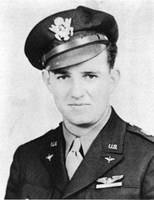 | Back to e-WV
| Back to e-WV
 The West Virginia Encyclopedia
The West Virginia Encyclopedia
 | Back to e-WV
| Back to e-WV
 The West Virginia Encyclopedia
The West Virginia Encyclopedia

Charlie Brown and Franz Stigler were enemies in war who later forged an unlikely friendship.
Charles “Charlie” Brown (April 15, 1922-Nov. 24, 2008) grew up in Weston, Lewis County. After high school he joined the Army Air Corps, where he learned to fly B-17 bombers. During World War II, Brown and his crew were part of the 379th Bombardment Group of the 8th Air Force, stationed in central England.
Franz Stigler (August 21, 1915-March 22, 2008) was born in southern Germany and started flying gliders as a boy. In 1942 Stigler, a Lufthansa airline pilot, was conscripted into the Luftwaffe, where he was a flight instructor and later became an ace fighter.
On December 20, 1943, Brown and his crew boarded their bomber, named Ye Olde Pub, for their first mission. They headed toward Bremen, Germany, where the bombers, numbering nearly 500, were to bomb a fighter aircraft factory.
Brown’s plane came under heavy fire from flak guns, yet reached its destination and dropped its bombs. With one engine gone and another damaged, the plane came under attack from German fighter planes. Most of the crew members were wounded, and the tail gunner was killed.
The plane began losing altitude and passed low over a German airfield, where Brown’s bomber was spotted by Franz Stigler who was refueling. Stigler jumped in his plane, a Messerschmitt Bf 109, intending to down the damaged bomber.
From his plane Stigler viewed the damaged bomber. Through the plane’s exposed ribs, he could see the crew members caring for their wounded crew mates. Recalling, as he later attested, what a former commanding officer had taught him about celebrating victories, not death, and about fighting with restraint, he decided to save the crew if he could, rather than take out the damaged bomber. Stigler motioned for the plane to land on German soil, but Charlie Brown ignored him and continued to fly toward the coastline, where batteries of flak guns awaited them.
To protect the American bomber, Sigler flew his plane in formation with the B-17, so the flak gunners would not fire on them. Once the two aircraft were over the North Sea, he motioned to Brown to fly the bomber to neutral Sweden. Unable to decipher Stigler’s motions, Brown continued to fly over open water. Knowing he could do nothing more for the crew, Stigler saluted the American pilot, turned his plane around and returned to Germany.
The bomber made it back to England. The tail gunner had been killed, but the rest of the crew survived and continued to fly. On April 11, 1944, they flew their 28th and final mission together. For their heroism, the crew members received the Silver Star, and Brown was awarded the Air Force Cross.
After the war, Stigler moved to western Canada, and Brown returned to West Virginia. Neither forgot their encounter in the sky.
In 1949, Brown returned to the Air Force, working in military intelligence. In 1990, Stigler spotted a letter Brown had written about the incident in a German military publication, and wrote to Brown, now retired and living in Florida.
The two war veterans met for the first time since the incident on June 21, 1990. Stigler later met other members of the crew whose lives were saved by his actions on that day in 1943. Brown and Stigler remained friends the rest of their lives, traveling across the country to tell their story to civic groups and other organizations. Stigler and Brown both died in 2008, just eight months apart.
Written by Becky Calwell